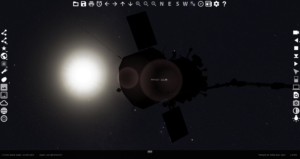Launched on August 4, 2018, the Parker Solar Probe (PSP) has the mission of studying the Sun for 7 years. Placed in a elliptical orbit, with its perihelion located at less than 0.17 astronomical units (AU) and its aphelion at the orbit of Venus, this NASA mission is full of achievements. Equipped with an efficient thermal shield that protects its structure from the flux emanating from the Sun and will raise the temperature to 1400 K at times, the probe is equipped with four instruments that will study the solar corona.

Indeed, the corona remains poorly understood even today. We know almost nothing about the accelerating mechanisms of the particle flux escaping from the upper atmosphere (the solar wind), nor about the origin of the high temperatures of the corona (1 million degrees K), which are a hundred times higher than those observed at the surface of the star.
A wide-angle coronagraph will capture three-dimensional images of the corona and the inner heliosphere. The FIELDS instrument will measure electric and magnetic fields, radio wave emissions, and plasma waves. ISIS (Integrated Science Investigation of the Sun) will provide more information about the characteristics of particles present in the solar atmosphere and the inner heliosphere, accelerated to high energies (from 10 keV to 100 MeV). Finally, the SWEAP (Solar Wind Electrons Alphas and Protons) instrument will study the electrons, protons, and helium ions that make up the solar wind.
On April 4, 2019, the probe ventured to within 25 million kilometers of the Sun, moving at a relative speed of 343,000 km/h with respect to it, making it the fastest object in human history. In 2023, PSP will come within 6 million km of the Sun.
By installing the Parker Solar module in WinStars, it is possible to visualize the probe’s position in real-time and follow the 24 planned orbits to uncover the secrets of our star’s atmosphere.





